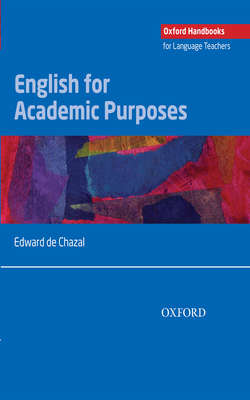Читать книгу English for Academic Purposes - Edward de Chazal - Страница 6
На сайте Литреса книга снята с продажи.
1 THE FIELD OF EAP
EAP as a research-informed practice
ОглавлениеEnglish for Academic Purposes (EAP) has evolved from its modest roots in the 1960s to become an emerging global phenomenon. University education is globalizing, English is becoming established as the medium of instruction in a diverse range of contexts, and international students are becoming increasingly mobile. Whilst EAP has developed to meet these students’ needs, it is not only students, but also their teaching staff who are becoming increasingly mobile. A small but growing area of EAP involves teaching these academics, which is discussed briefly in Chapter 2.
To understand what EAP is and how it reached this stage of development, it is useful to look briefly at its current context, before going back half a century to its beginnings. During this time, EAP has been influenced by linguistics and educational research, and a number of trends, theories, and practices from different parts of the world, which go some way to explaining its current diversity and complexity. This chapter discusses the emergence of EAP, dispels various myths, compares EAP with other English language teaching contexts, and examines the major influences on the field, before returning to its current global context and looking ahead.
Contextualization
The field of English language teaching (ELT) is diverse, global, and complex. Within the field many different sectors, approaches, and cultures coexist. These sectors include:
• general teaching English as a foreign language (known as TEFL, EFL, or ELT, i.e. English language teaching)
• teaching English as a second language (TESOL, TESL, ESOL, or ESL)
• more specialized sectors including English for specific purposes (ESP), English for science and technology (EST), English for occupational purposes (EOP), and English for academic purposes (EAP).
EAP, the focus of this book, has itself given rise to two further sub-sectors: English for general academic purposes (EGAP) and English for specific academic purposes (ESAP). ESAP can cover a variety of types of English for specific academic and professional purposes, such as English for law, architecture, or nursing.
The fact that this very brief overview contains a dozen or so abbreviations and acronyms illustrates the diversity and complexity of the field, and the potential for confusion. The same sector can have different names. Different sectors can, in effect, have the same name. TESOL, for example, is associated with the USA and is taken to mean the teaching of English to speakers of other languages; in its northern neighbour, Canada, the abbreviation for this activity is more likely to be TESL. In the UK, meanwhile, a distinction is usually made between the teaching of English to speakers of other languages who are learning it anywhere (EFL/ELT, or TESOL in some contexts such as MA programmes), and those, such as migrants, who are learning it in the target language community, for example the UK, in order to integrate into that community (ESOL or ESL). In practice, some of the names and abbreviations are used interchangeably. As the field of ELT develops, some of the names, though not necessarily the sectors, are being used less – for instance EST (English for science and technology), once the ‘senior branch of ESP’ (Swales 1985: x) is now supplanted by business English and EAP – while others represent growing sectors and are becoming more widely used and familiar (EAP).
In order to define and position EAP within its broader context of English language teaching, a brief historical overview illustrates how EAP emerged from the need to teach English language in specialized, academic contexts.
